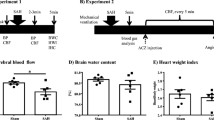Summary
The intramural fluid circulation of the cerebral arterial wall was investigated using horseradish peroxidase (HRP) as a tracer which was injected intravenously or intracisternally in dogs with or without subarachnoid haemorrhage (SAH). In the control dogs, the endothelial barrier function was confirmed for intravenous HRP, whereas the intracisternal HRP passed freely through the interstitial spaces of the adventitia and media to reach the intima within a few minutes. However, on the 5th day after SAH the barrier function of the intima for intravenous HRP was lost. In addition, there was a marked decrease in the amount of HRP reaching the intima when injected intracisternally. The intercellular space appears to be the main route for leakage of HRP into the subendothelial layer from the arterial lumen. Obstruction of the interstitial space in the adventitia by blood elements may be the cause of the disturbed intramural circulation of cerebrospinal fluid. These results suggest that this disturbance in the intramual circulation of the cerebral arterial wall plays a role in the development and/or progression of delayed cerebro-arterial narrowing after SAH.
Similar content being viewed by others
References
Alexander III E, Black PM, Liszczak TM, Zervas NT (1985) Delayed CSF lavage for arteriographic and morphological vasospasm after experimental SAH. J Neurosurg 63: 949–958
Brightmann MW, Reese TS (1969) Junctions between intimately apposed cell membranes in the vertebrate brain. J Cell Biol 40: 648–677
Clower BR, Sullivan DM, Smith RR (1984) Intracranial vessels lack vasa vasorum. J Neurosurg 61: 44–48
Fisher CM, Kistler JP, David JM (1980) Relation of cerebral vasospasm to subarachnoid hemorrhage visulalized by computerized tomographic scanning. Neurosurgery 6: 1–9
Joris I, Majno G (1981) Endothelial changes induced by arterial spasm. Am J Pathol 102: 346–358
Kurozumi T (1975) Electron microscopic study on permeability of the aorta and basilar artery of the rabbit. With special reference to the changes of permeability by hypercholesteremia. Exp Mol Pathol 23: 1–11
Liszczak TM, Varsos VG, Black PM, Kistler JP, Zervas NT (1983) Cerebral arterial constriction after experimental subarachnoid hemorrhage is associated with blood components within the arterial wall. J Neurosurg 58: 18–26
Nakata Y (1977) An experimental study on the vascular lesions caused by obstruction of the vasa vasorum. Jap Cir J 31:275–287
Osaka (1977) Prolonged vasospasm produced by the breakdown products of erythrocytes. J Neurosurg 47: 403–411
Reese TS, Karnovsky MJ (1967) Fine structural localization of blood-brain barrier to exogenous peroxidase. J Cell Biol 34:207–217
Saito I, Sano K (1979) Vasospasm following rupture of cerebral aneurysms. Neurol Med Chir (Tokyo) 19: 103–107
Sakurai I, Yamada T, Yoshimura M, Gomi B, Kobayashi T, Ikeda H (1980) Pathological study on the role of intramural circulation of coronary arteries in the progression of coronary atherosclerosis. Asian Med J 23: 870–890
Sano K, Saito I (1980) Early operation and washout of blood clots for prevention of cerebral vasospasm. In: Wilkins RH (ed) Cerebral arterial spasm. Williams & Wilkins, Baltimore, pp 510–513
Sasaki T, Kassel NF, Yamashita M, Fujiwara S, Zuccarello M (1985) Barrier disruption in the major cerebral arteries following experimental subarachnoid hemorrhage. J Neurosurg 63: 433–440
Suzuki J, Onuma T, Yoshimoto T (1979) Results of early operation on cerebral aneurysm. Surg Neurol 11: 407–412
Tanabe Y, Sakata K, Yamada H, Ito T, Takada M (1978) Cerebral vasospasm and ultrastructural changes in cerebral arterial wall. J Neurosurg 49: 229–238
Tani E, Yamagata S, Ito Y (1978) Intercellular granules and vesicles in prolonged cerebral vasospasm. J Neurosurg 48: 179–189
Varsos VG, Liszczak TM, Han DH, Kistler JP, Vielma J, Black PM, Heros RC, Zervas NT (1983) Delayed cerebral vasospasm is not reversible by aminophiline, nifedipine, or papaverine in a “two hemorrhage” canine model. J Neurosurg 58: 11–17
Wagner HJ, Pilgrim CH, Brandl J (1974) Penetration and removal of horseradish peroxidase injected into the cerebrospinal fluid: Role of cerebral perivascular spaces, endothelium and microgria. Acta Neuropath (Berl) 27: 299–315
Zervas NT, Liszczak TM, Mayberg MR, Black PM (1982) Cerebrospinal fluid may nourish cerebral vessels through pathways in the adventitia that may be analogous to systemic vasa vasorum. J Neurosurg 56: 475–481
Author information
Authors and Affiliations
Rights and permissions
About this article
Cite this article
Uemura, Y., Okamoto, S., Handa, Y. et al. Disturbance in the intramural circulation of the major cerebro-pial arteries after experimental subarachnoid haemorrhage. Acta neurochir 89, 71–76 (1987). https://doi.org/10.1007/BF01406670
Issue Date:
DOI: https://doi.org/10.1007/BF01406670




